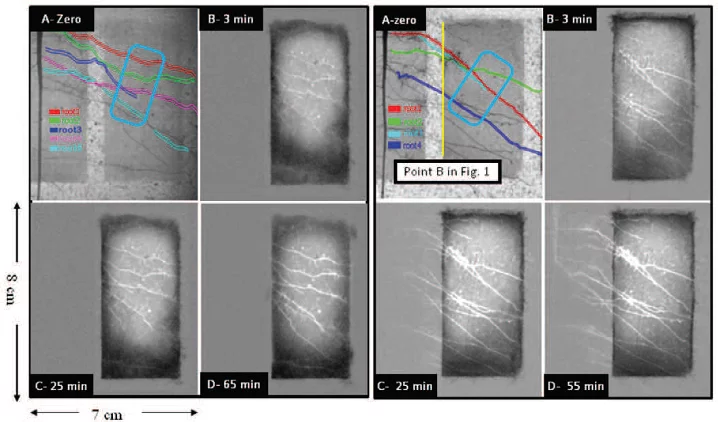The water balance in living plants serves a vital role from extracting water from the soil to transporting it to the shoot as well as throughout the plant and for sustaining transpiration. To fulfill these functions plants and their specific parts have a complex anatomical structure with varying cell layers of e.g. varying hydraulic conductivities. This behavior includes the rhizosphere, which is the soil fraction close to the roots in which the chemistry and microbiology are influenced by their growth, respiration, and nutrient exchange.
The plants moderate the moisture content in the rhizosphere to maintain an efficient content for water uptake from the roots. This is achieved through a lipid called mucilage. The mucilage helps to keep the rhizosphere wetter during drought and prevents over-wetting upon irrigation [1].
Thanks to neutron imaging it has been confirmed that the water transport through the roots is significantly greater during daytime than during the night [2]. Recent studies with our imaging instruments underline that different fluxes are achieved through different pathways in the root tissue. The results suggest that during night time the water moves predominantly through the cell walls while the higher flux at day time uses the apoplast pathways [3].
Investigations of water transport in porous media and in particular in soils have been done since the very early developments of neutron imaging. The method is ideal to observe the water distribution due to the high sensitivity to hydrogen. Also, the contrast between the two isotopes 1H and 2H is useful to follow transport processes in the soil as well as within the roots. Today, the imaging method has been refined to allow rapid acquisition of time series even of three-dimensional images using on-the-fly tomography. This can also be combined with x-rays as a second modality to increase the contrast for ambiguous changes in the attenuation coefficients in particular in the soil phases.
Publications
- Zarebanadkouki, M., Ahmed, M.A. & Carminati, A. Hydraulic conductivity of the root-soil interface of lupin in sandy soil after drying and rewetting. Plant Soil 398, 267–280 (2016). https://doi.org/10.1007/s11104-015-2668-1
- Zarebanadkouki, M., Kim, Y., Moradi, A., Vogel, H., Kaestner, A. and Carminati, A. (2012), Quantification and Modeling of Local Root Water Uptake Using Neutron Radiography and Deuterated Water. Vadose Zone Journal, 11: vzj2011.0196. https://doi.org/10.2136/vzj2011.0196.
- Zarebanadkouki, M., Trtik, P., Hayat, F., Carminati, A., & Kaestner, A. (2019). Root water uptake and its pathways across the root: quantification at the cellular scale. Scientific Reports, 9(1), 12979 (11 pp.). https://doi.org/10.1038/s41598-019-49528-9
Collaboration
- Prof. A. Carminati, ETH Zürich
Contact
- Dr. A. Kaestner, anders.Kaestner@psi.ch , +41 56 310 4286


